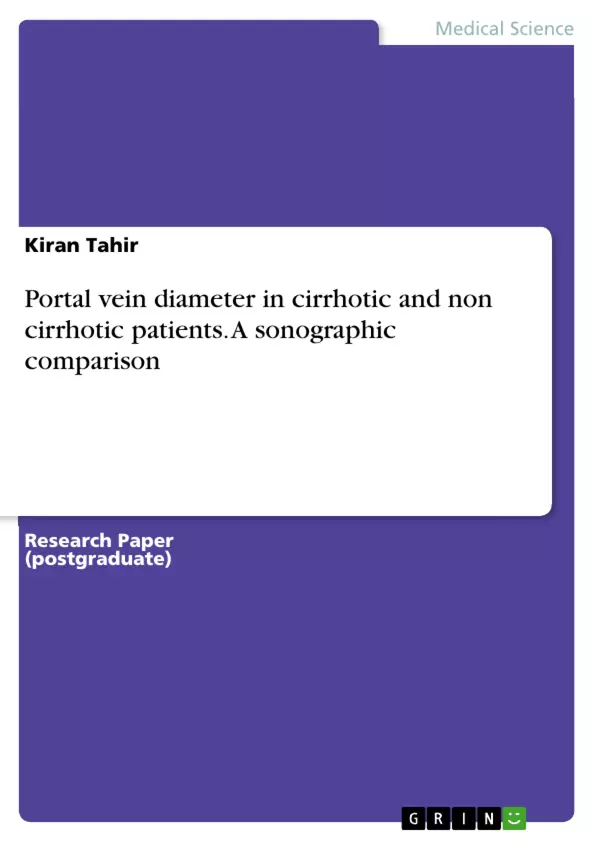This publication aims to compare the portal vein diameter in cirrhotic and non-cirrhotic patients through ultrasound. Liver cirrhosis is a clinical condition in which the normal liver parenchyma is replaced with fibrosis in such a situation it becomes difficult for blood to easily pass through the Portohepatic venous system.
Therefore, the portal vein becomes engorged and increases in diameter, while blood flow velocity reduces. Portal hypertension is clearly-defined as the rise of portal venous pressure, largely due to cirrhosis, which leads to increased hepatic vascular resistance and engorgement of the blood in the portal venous system.
This disease may result in an array of disorders, like that the development of collateral vessels for returning of the blood to the right atrium with the potentiality for intestinal bleeding, development of ascites, encephalopathy, and formation of a 11 hyper-dynamic circulation involving peripheral and splanchnic vessels, related with the malfunction of kidneys, the heart, the lungs, and the brain.
Table of Contents
- LIST OF ABBREVIATIONS
- ABSTRACT
- CHAPTER 1: INTRODUCTION
- CHAPTER 2: REVIEW OF LITERATURE
- CHAPTER 3:
- 3.1: OBJECTIVES
- 3.2: HYPOTHESIS
- 3.3: PROBLEM STATEMENT
- 3.4: OPERATIONAL DEFINITIONS
- CHAPTER 4: MATERIAL &METHODS
- 4.1: Study design
- 4.2: Setting
- 4.3: Study duration
- 4.4: Sample size
- 4.5: Sampling technique
- 4.6: Sample Selection
- 4.6.1: Inclusion criteria
- 4.6.2: Exclusion criteria
- 4.7: Equipment(s)
- 4.8: Ethical Considerations
- 4.9: Data Collection Procedure
- 4.10: Data Analysis
- 4.11: Gantt Chart
- CHAPTER 5: RESULTS
- CHAPTER 6: DISCUSSION
- CHAPTER 7:
- 7.1: Conclusion
- 7.2: Recommendations
- 7.3: Limitations
- CHAPTER 8: REFERENCES
- CHAPTER 9: ANNEXURE
- 9.1: Consent Forms
- 9.2: Questionnaire
- 9.3: Supplementary Materials/Tables
- 9.4: Data Sheets
- 9.5: Permission letters for PGS (IRB, Data collection)
Objectives and Key Themes
This research aims to compare the portal vein diameter in patients with cirrhosis and those without cirrhosis using ultrasound imaging. The study investigates the relationship between portal vein diameter and the presence of cirrhosis, analyzing factors that may influence this relationship.
- The role of ultrasound in diagnosing and assessing liver disease
- The relationship between portal vein diameter and the presence of cirrhosis
- Factors influencing portal vein diameter in cirrhotic and non-cirrhotic patients
- The clinical implications of findings for patient management
- The potential for ultrasound as a valuable tool in diagnosing and monitoring liver disease
Chapter Summaries
The research begins with an introduction to the topic of liver disease, focusing on the prevalence of cirrhosis and the significance of portal hypertension. It then delves into a comprehensive review of existing literature exploring various aspects of portal vein diameter and its relationship with cirrhosis.
The study design, setting, and methodology are outlined in Chapter 4, detailing the inclusion and exclusion criteria for participants, data collection procedures, and ethical considerations. Chapter 5 presents the findings of the study, analyzing the measurements of portal vein diameter in both cirrhotic and non-cirrhotic patient groups.
Chapter 6 provides a detailed discussion of the results, comparing the findings with previous studies and highlighting the key implications of the research. The limitations of the study are acknowledged and recommendations for future research are presented in Chapter 7.
Keywords
The primary keywords associated with this study include portal vein diameter, cirrhosis, ultrasound, liver disease, portal hypertension, non-alcoholic fatty liver disease, clinical implications, and diagnostic tools.
- Quote paper
- Kiran Tahir (Author), 2022, Portal vein diameter in cirrhotic and non cirrhotic patients. A sonographic comparison, Munich, GRIN Verlag, https://www.grin.com/document/1316042



